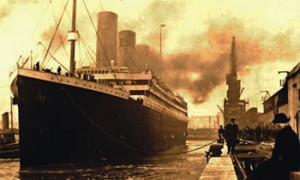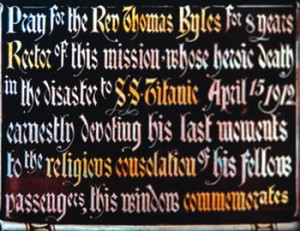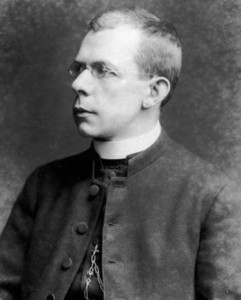Hero of the Titanic: Father Thomas Byles
The sinking of the Titanic on the 12th of April 1914 generated many stories of bravery and heroism. One of the least known of these concerned Father Thomas Byles, a Catholic priest who died praying for those left on board the ‘unsinkable’ vessel.
The eldest of seven children, he was born on February 26th 1870 into a Yorkshire Congregationalist family. He was named Roussel Davids, his first name after a Huguenot ancestor and Davids being his mother’s maiden name. At the age of fifteen he began four years education at Leamington College and Rossall School in Lancashire and it was here that the first doubts arose about the faith he’d been born into. He was not comfortable with its historical beginnings and gradually drifted away from the Congregational Church. After entering Balliol College in Oxford in 1889, Roussel joined the Church of England. He was drawn to the apologetics and the ritual, such as confession and meditative prayer. However, five years later he was still searching, finding himself “unable to recognise the Anglican position” though no more satisfied with the “Roman position” according to a letter he wrote to his brother William.
His indecision ended three months later, in May 1894, when he was baptised in St Aloysius Catholic Church in Oxford. Shortly after, on graduating, he left Oxford and went on retreat to Manresa in Spain before visiting his brother who was studying in southern Germany. From there Roussel visited a monastery in Switzerland where he was briefly employed as a tutor for one of the sons of Prince von Waldburg-Wolfegg-Waldstein.
Back in England the following year, he began thinking about the priesthood and after a short spell in a seminary near Birmingham – the climate did not agree with him – he went to St Edmund’s College and Seminary in Hertfordshire. Here, Roussel was able to teach while continuing his studies. It appears this wasn’t an entirely successful time for him though. His health wasn’t good, being prone to fits, and after his years in Oxford the seminary was less than stimulating for him.
In 1899 he entered Beda College in Rome, the next step in his study for the priesthood and two years later he received a Bachelor of Divinity from Gregorian University. The following year on the 15th of June 1902 he was ordained and changed his name to Thomas. After spending a few months in Rome, he returned to England and by February 1903 was living in West London, where he and four others formed the Catholic Missionary Society, an organisation dedicated to Catholic conversion, usually from English Protestantism. Our Lady Immaculate and the Holy Angels in Kelvedon, Essex was Fr Thomas’s next assignment, before being transferred to the large parish of Ongar in Essex in 1905.
The parish of Ongar, which included the town of Epping and several small villages, may have been large, but the congregation was small – and poor. The young priest was popular with his flock and could often be seen cycling the Essex lanes on his way to visit Catholics, practising and lapsed. He lost no opportunity to make the little church central to the community, on one occasion organising boxing lessons in a shed behind the church when some young men showed an interest in the sport.
In 1912, Father Byles was asked by his brother William who lived in New York, if he would officiate at his wedding at St Augustine’s Catholic Church in Brooklyn. William, like his brother, went through much soul-searching before converting to the Catholic faith and had then joined the Jesuits. However, he later left the order and emigrated to America, starting his own business there.
Two days before setting sail, Father Byles had a visit from a friend, Monsignor Edward Watson, who voiced his concern about the dangers of icebergs at that time of year. Little did the Monsignor know what the outcome would be when he farewelled his friend with the words, “I hope you’ll come back again.”
The Belfast-built ship was an impressive 46,328 tons, the largest ship to set sail at that time, and was deemed ‘unsinkable’. The White Star liner was on her maiden voyage and was the epitome of luxury, sporting a swimming pool, gymnasium, libraries and the ultimate in dining and accommodation. In total, the ship was carrying around 2,220 people which included more than 1,300 passengers, many being emigrants to the New World from Britain and across Europe and the remainder crew.
On the 10th of April the young priest boarded the Titanic complete with portable altar and everything needed for celebrating Mass, for which arrangements had already been made. Two other priests were on board, a Lithuanian and a German, so Mass would be held daily. While not altogether surprising, there’s a certain irony that Father Byles’s sermon on that Sunday the 14th of April should have centred on shipwrecks, albeit spiritual: prayer was the lifebelt while the sacraments saved souls from temptation in times of spiritual shipwrecks.
Just before midnight later that day, the ship struck the iceberg. Father Byles was pacing the upper deck reciting the breviary at the time and went straight down to the third class deck to calm the people. According to one eye witness, “the passengers were immediately impressed by the absolute self-control of the priest.” When he began to recite the rosary, “the prayers of all, regardless of creed, were mingled and all the responses, ‘Holy Mary’, were loud and strong.” After hearing confessions and giving absolution and blessings, he led the way to the boat deck and helped people into the lifeboats. At least twice he was offered a place in one but refused.
According to another survivor, Father Byles was seen reading the priest’s book of hours, which he then pocketed and “gathered the men about him and, while they knelt, offered up prayer for their salvation.” Throughout the chaos that ensued he continued to bless people, hear confessions and pray with them. When all the lifeboats had gone he made his way to the aft of the ship and began to pray the rosary with all those left on board. As the ship slowly sank, he recited the act of contrition and blessed everyone.
One survivor said that as the last lifeboat pulled away, she could hear the voice of the priest praying and the responses, “then they became fainter and fainter, until I could only hear the strains of ‘Nearer My God to Thee’ and the screams of the people left behind.”
Father Byles’s body was never found.
It’s worth noting that there were 20 lifeboats installed on the Titanic, four more than the required maritime ruling for the vessel’s size. Despite only catering for around half those on board, the reasoning was that the lifeboats were only intended to carry passengers to the safety of another ship. It was expected distress calls were speedily answered. The controversy concerning the tragic events of that night continue to this day.
William Byles and his bride Katherine Russell were married on the 20th of April at St Paul’s Church in New York, the officiating priest being a friend of Katherine’s. However, instead of a reception, those attending the wedding went home to change before returning for a Requiem Mass for Father Byles.
Later that same year William and Katherine travelled to Europe, visiting Rome, and had an audience with Pope Pius X who gave them a special blessing. Father Byles, he said, was a martyr for the Church.
Among the memorials dedicated to him includes one in St Helen’s Church in Ongar. A stained glass window depicts St Patrick, the Good Shepherd and St Thomas Aquinas, with a small plaque in the corner detailing his heroic deed.
Between 1,500 and 1,635 lives were lost that night. A true figure will never be known due to those travelling under aliases and last minute cancellations. Father Thomas Byles was among them but he was also, according to a report in the Essex Chronicle on the 2nd of May 1912, “the rescuer of innumerable souls on a storm tossed ocean.” At one of several Requiem Masses said at the small church in Ongar, Mgr Watson compared him to St Paul saying though (the Saint) “suffered from physical ailments and was only small in stature, yet he was the great Apostle of the Gentiles. In like manner, the late Father Byles, although of a humble exterior, was a man of great learning, great zeal, possessed a kindly love for the poor and a spirit of great humility.” Father Thomas Byles couldn’t have received a greater compliment.


 Entries(RSS)
Entries(RSS)